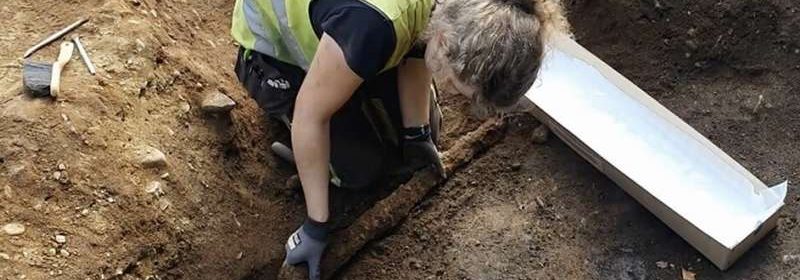Norwegian Archaeologists Unearth Grave of Left-Handed Viking Warrior

Norwegian Archaeologists Unearth Grave of Left-Handed Viking Warrior
A group of Viking tombs from the 9th or 10th centuries have recently been discovered by excavators in Vinjeøra, Norway, including one whose unusual layout suggests it may contain the cremated remains of a left-handed warrior.
Most of the swords used in Viking burials are placed on the right side of the grave, George Dvorsky describes for Gizmodo. But this person was interspersed with his left-hand weapon.

In the combat, Vikings held their sword with one hand and held a shield with the other arm. Right-handed warriors kept their scabbard or sheath hanging on the left side to make it easy to reach across and pulling out their blade.
When these warriors died, they were buried with their sword and scabbard on the right side in a reversal of how they had appeared in life.

“The idea is that this placement must reflect some beliefs that were important in the mortuary rites,” excavation manager Raymond Sauvage, an archaeologist at the Norwegian University of Science and Technology (NTNU), tells Live Science’s Laura Geggel. “Other Viking items are often found to be placed mirror of what is normal. Several archaeologists, therefore, believe that this may reflect a belief that they understood the afterlife to be mirrored of the normal world.”
Researchers from NTNU are excavating the area ahead of expansion of a highway, according to a statement. So far, finds include the overlapping graves of several warriors—including the probably left-handed Viking—and a burial thought to hold the ashes of an early Viking woman.
The archaeologists made this gender determination based on the presence of artifacts such as an oval brooch, a pair of scissors and several colored beads.
Combined, the proposed woman’s cremated remains weigh just over four pounds, or the estimated weight of a whole body. Most Iron Age burials contain only half a pound of material. For now, Gizmodo notes, the archaeologists don’t have an explanation for the discrepancy.
The warriors in question were laid to rest in a large ditch surrounding a shared burial mound.
“It was obviously important to lie next to or in the burial mounds and the ring ditches around them,” says Sauvage in the statement.
He adds, “We can imagine that this burial practice is an expression of how important the family’s ancestors were on a farm in Viking times. … This confirmed the family’s ownership of the land, and being buried close to an important ancestor or forefather (or -mother) was perhaps also a way to be included in the community of ancestral spirits.”
The Vikings believed that staying spiritually connected to their ancestors was of paramount importance. By interring loved ones in a burial mound on the family farm, those still living ensured the deceased remained present both physically and as companion spirits called fylgjur, according to Sauvage.
The left-handed warrior’s grave included a full set of weapons: namely, an axe, spear, shield and sword. During the Middle Ages, the statement notes, farmers were required by law to procure these weapons, beginning with the axe and shield. Most Viking warriors were, in fact, men who owned farms.

As Live Science reports, the newly discovered, 1,100-year-old sword measures nearly three feet long and is heavily corroded.
“I’m a little surprised at how heavy it was,” observes archaeologist Astrid Kviseth in the statement. “I don’t exactly know how heavy a sword is, but it had some heft to it. You would have had to be pretty strong to be able to swing this sword.”
The scientists theorize that the warrior buried with a sword on the left side of his grave would have worn the scabbard on his right side and therefore held it with his left hand.
Still, Sauvage reflects, “It’s hard to say.”

Future research on the artifacts and remains will determine the individuals’ sex and age. The sword, meanwhile, is set to go the university’s conservation laboratory, where the team will examine it with X-rays to determine what’s hiding underneath 1,100 years’ worth of rust.